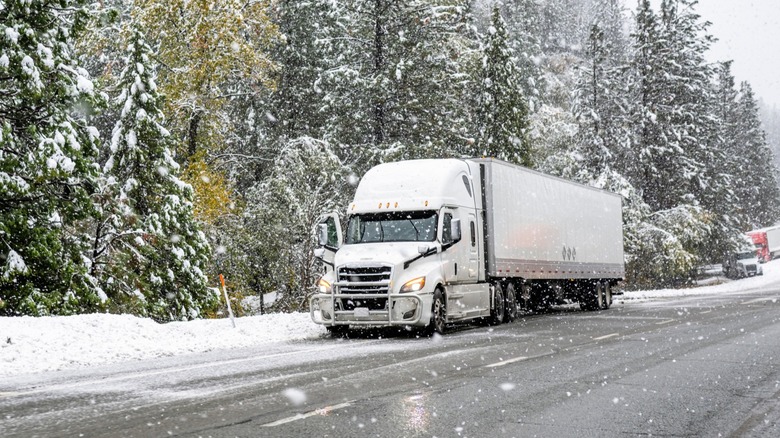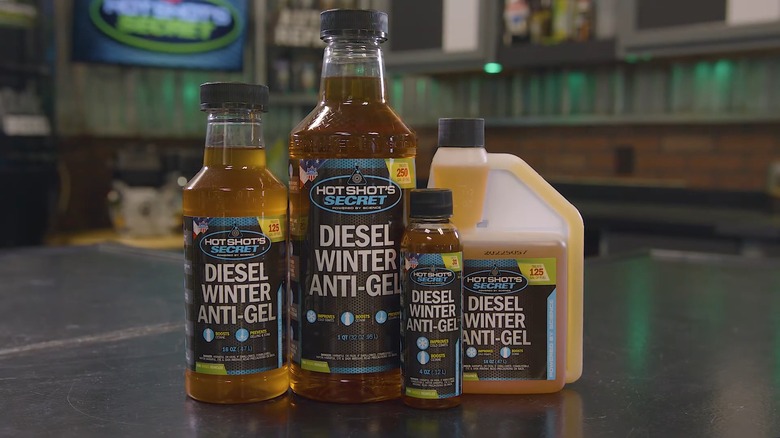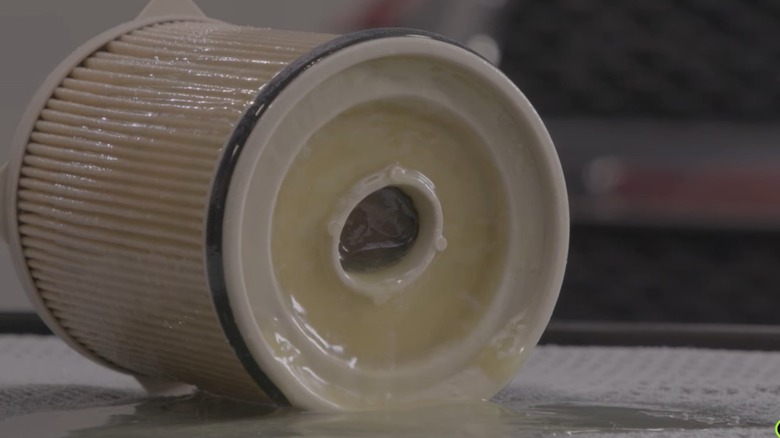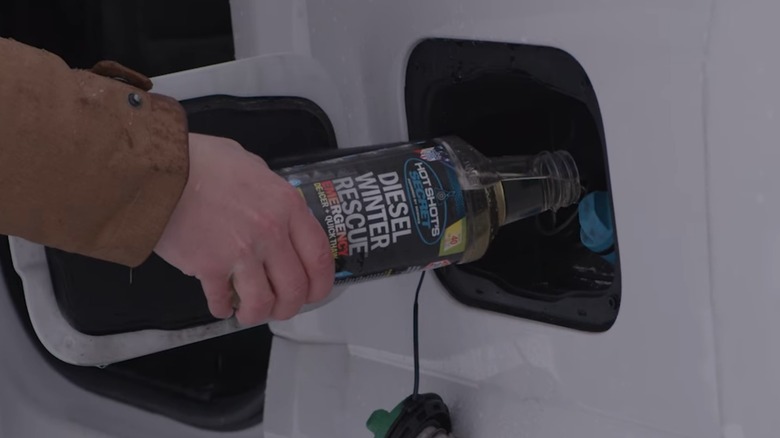How To Prevent Diesel Fuel From Gelling (And Why It Happens)
Diesel engines power more than you may realize. While diesel was once considered a useless byproduct of the crude oil refinery process, it's now responsible for powering everything from freight trains, buses, and trucks to military equipment, farming machinery, boat engines, and more. But while diesel fuel can provide surprisingly efficient power, it also comes with at least one downside: the potential to gel. It's a sticky problem — literally — and it can cause some annoying issues, including the inability to start your vehicle in the morning.
Diesel fuel can technically gel at around 32 degrees Fahrenheit, but that's pretty rare. Usually, diesel fuel starts gelling when exposed to temperatures between 10 and 15 degrees Fahrenheit for extended stretches of time. That means that, fortunately, diesel gelling tends to only be a problem for people living in extremely cold areas, like very far north or in the mountains. However, because long-haul truckers frequently travel through these areas, diesel fuel gelling can be a real threat.
Luckily, it's also pretty easy to prevent diesel fuel from gelling. One of the best ways to avoid the problem is to keep your fuel tank at least halfway full overnight or whenever your engine will be turned off for long periods. Parking indoors whenever possible, using a block heater, and buying special fuel can also help keep the issue at bay. If you're interested in a deeper dive into the ways to prevent diesel fuel gelling, some of its symptoms, and why it happens in the first place, stick around. As a former professional mechanic and lifelong gearhead, I'll cover it all.
There are a couple of ways to prevent diesel fuel from gelling
As mentioned, one of the best ways to prevent diesel fuel from gelling is to keep your tank as full as possible, especially when you plan to turn the engine off for prolonged periods. That's due primarily to the fact that when your tank is full or close to being full, it's more difficult for condensation to form, allowing water to lower the diesel's freezing point.
If you're in a particularly frigid area, you may want to take some extra steps to safeguard yourself and your vehicle against diesel gelling. Besides keeping your tank full, you should look for gas stations that sell winterized diesel fuel. This special type of diesel contains an additive designed to prevent your fuel from gelling. If you're in a very cold area, like the far north, you can frequently find stations selling this type of diesel during cooler months.
Other methods you can use to prevent diesel fuel gelling include adding special additives to your fuel tank, using a block heater, and parking indoors. If you have access to a garage and your vehicle is small enough to fit inside, you should always park indoors when it's especially cold out. However, that doesn't apply to truckers in most cases. Instead, diesel fuel additives are an easy and efficient way to prevent gelling, even if you can't park indoors. These products are designed to prevent gelling, but you must add them while the fuel is still in good condition. Then, they allow you to transform your standard diesel into a winterized version. Finally, you can purchase a block heater and fuel tank heater to keep your motor and fuel system warm, even when the vehicle is turned off.
Why does diesel fuel gelling happen in the first place?
The gelling problem ultimately boils down to the fact that diesel fuel contains paraffin wax particles. In fact, diesel was originally considered to be nothing more than a waste product of the process used to extract paraffin from crude oil. These days, diesel sees a lot of use and is considered to be a valuable and versatile fuel source. However, it still contains paraffin wax particles, which can lead to fuel gelling.
As the temperature drops, those waxy particles begin to solidify, with fuel gelling occurring in stages. At around 32 degrees Fahrenheit, crystals can begin forming in your diesel fuel. As the temperature falls lower and lower, the fuel starts to thicken up and become increasingly cloudy. Finally, once the fuel has been exposed to low temperatures (usually between 10 and 15 degrees Fahrenheit) for a long enough period, it can solidify completely, forming the substance known as diesel fuel gel.
The problem is exacerbated by the presence of condensation and water, which can form when your fuel tank is empty or mostly empty. When condensation builds in the fuel system, water forms. That water can freeze on its own, but it can also help lower the freezing point of your diesel fuel when the two mix together. That's why keeping your fuel tank full or nearly full is one of the best ways to prevent diesel fuel from gelling.
What are the signs of diesel fuel gelling?
If you're worried about your diesel fuel gelling in the winter, don't stress too much. For one, unless you live in an area that faces extremely cold weather for prolonged periods, diesel gelling should probably be toward the bottom of your list of concerns. Additionally, the symptoms of diesel fuel gelling are pretty easy to spot.
One of the most common signs that your diesel fuel has gelled is an inability to start your vehicle. This issue most frequently occurs in the morning, after the fuel has had a chance to cool overnight. It happens because that gelled fuel gunks and clogs up things like your fuel lines and filter, preventing any liquid diesel that remains from flowing smoothly to the engine. Unfortunately, there are various issues that can cause your engine not to start. However, if you drive a diesel vehicle and it randomly fails to start on an exceptionally cold morning, there's a decent chance gelled fuel is the culprit.
Outside of an inability to start your car, you may also experience performance problems if your diesel fuel is starting to gel. That translates primarily to things like reduced acceleration and overall drops in power, and it happens when the fuel is starting to gel but still capable of moving through the system to a certain extent. This issue is more likely to happen when your fuel tank is low, as it allows excess water and condensation into the fuel, lowering its freezing point.
What to do if your diesel fuel gels?
If your diesel fuel has already gelled or you suspect that it has, you might be wondering what your options are. While diesel fuel gelling isn't the most severe problem your engine can face, it can lead to more serious issues, like damage to the fuel tank and pump. Because of that, you should address the problem as soon as possible.
One of the first things you'll need to do if your diesel fuel gels is replace the fuel filter. The filter is one of the components that suffers the most from a gelling issue, as it's designed to filter out any gunk or solids that form in the fuel system. Depending on the severity of the problem, you may also have to replace things like water separators.
Once you've replaced or cleaned any extremely dirty or clogged-up parts, you'll have to add a de-gelling product to your vehicle's fuel system. These chemicals are different from anti-gel products — while anti-gel additives are designed to prevent the formation of gel in diesel fuel, they can't remove gel once it has already formed. After you add the chemicals, you need to start the engine and let it idle. Remember to follow the instructions on the bottle regarding how much fluid to add, and if you have any doubts, reach out to a pro.
All that said, the best way to address a diesel fuel gelling problem is to visit a professional mechanic from the start. You can follow the above steps to DIY the fix, but a professional auto repair technician will be able to do a more thorough job and identify any potential damage before it becomes more severe.




